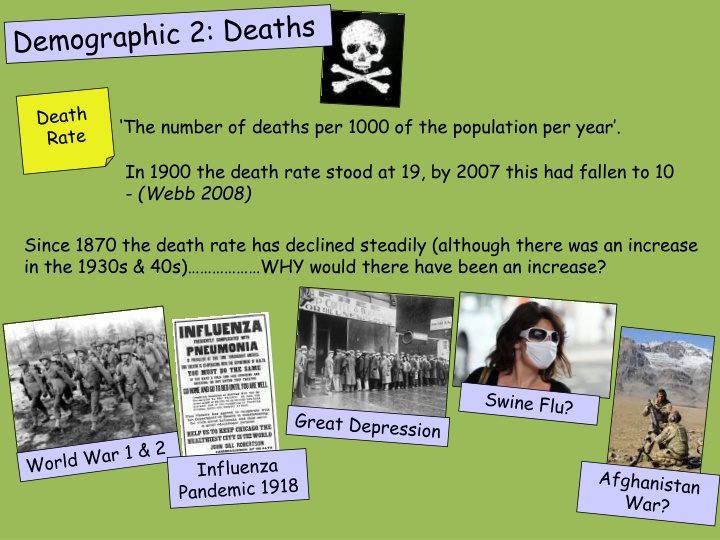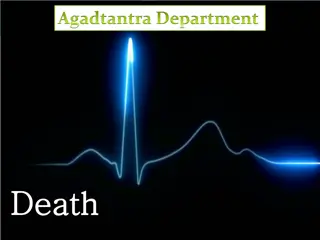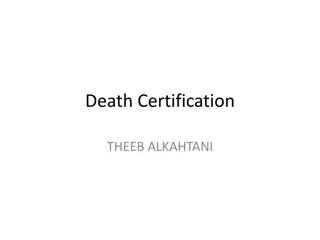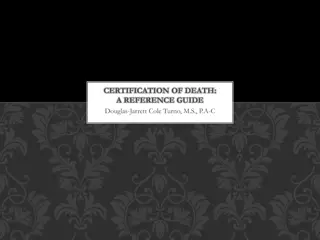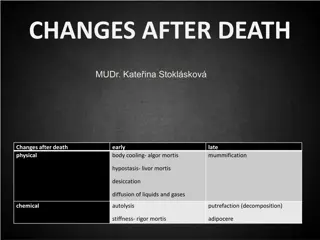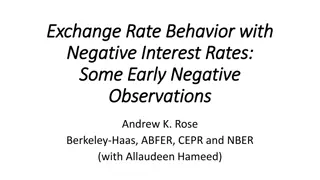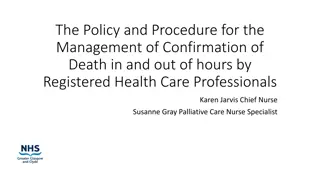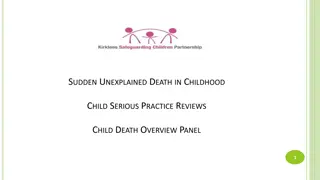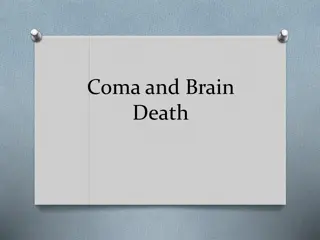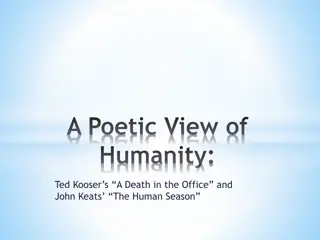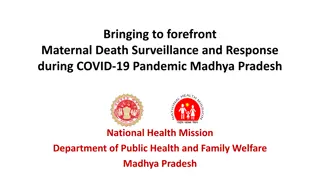Declining Death Rates: Reasons and Impacts
The decline in death rates since 1870 has been attributed to factors such as reduced deaths from infectious diseases and advancements in healthcare. Followers of Darwin's Natural Selection Theory suggest that susceptibility to disease has decreased over time. However, sociologists argue for social explanations. Despite medical improvements, there have been periods where death rates increased due to poor obstetric knowledge. Various measures have been implemented to enhance food, health, pollution control, and housing conditions. The arguments surrounding declining death rates and increasing life expectancy are widely debated.
Download Presentation

Please find below an Image/Link to download the presentation.
The content on the website is provided AS IS for your information and personal use only. It may not be sold, licensed, or shared on other websites without obtaining consent from the author.If you encounter any issues during the download, it is possible that the publisher has removed the file from their server.
You are allowed to download the files provided on this website for personal or commercial use, subject to the condition that they are used lawfully. All files are the property of their respective owners.
The content on the website is provided AS IS for your information and personal use only. It may not be sold, licensed, or shared on other websites without obtaining consent from the author.
E N D
Presentation Transcript
See full size image The number of deaths per 1000 of the population per year . In 1900 the death rate stood at 19, by 2007 this had fallen to 10 - (Webb 2008) Since 1870 the death rate has declined steadily (although there was an increase in the 1930s & 40s) WHY would there have been an increase? http://t0.gstatic.com/images?q=tbn:p6DsXNkHMtmhIM:http://garybrandastrology.com/images/1918Flu_Poster_Chicago.gif http://t0.gstatic.com/images?q=tbn:VSqc7M5iZb1jGM:http://www.socialist.net/images/stories/afghan_war1.jpg
Tranter (1996): One of the major reasons for this decline in deaths since 1850 is due to a decline in deaths from infectious diseases such as small pox, TB, measles & typhoid. http://t0.gstatic.com/images?q=tbn:Hs4IZF7whKfN_M:http://www.designbliss.com/wp-content/uploads/2007/10/gravestone_pumpkin.gif http://t0.gstatic.com/images?q=tbn:_Mcw_aJaIDRPVM:http://jeftavarwijk.files.wordpress.com/2009/09/051111_darwin_portrait_02.jpg Followers of Darwin s Natural Selection Theory would argue that disease has lessened as those who were most susceptible died & didn t reproduce Sociologists prefer Social Explanations however ..
http://t3.gstatic.com/images?q=tbn:FoKTJ8fz97e04M:http://www.deliadriano.biz/Portals/0/veg%2520box%25202.jpghttp://t3.gstatic.com/images?q=tbn:FoKTJ8fz97e04M:http://www.deliadriano.biz/Portals/0/veg%2520box%25202.jpg Readily available products & a wealthier population mean that good food is available to the majority. Do you agree? McKeown disagrees with this by suggesting that during times of improved nutrition some illnesses actually rose. http://t2.gstatic.com/images?q=tbn:fY-O8OH8T9VcVM:http://29andfighting.files.wordpress.com/2009/07/ct-scan.jpg Although medical improvements have impacted on the death rate dramatically since 1950 (NHS 1949), this has not always been the case. Tranter argues: As late as the 1930s, levels of obstetric knowledge & technique were so poor that they were more likely to increase rather than decrease death rates in childbirth Measures have been implemented to improve food, health, pollution & housing. Can you think of any examples?
http://t1.gstatic.com/images?q=tbn:yjNN21_z1icPPM:http://static.squidoo.com/resize/squidoo_images/-1/draft_lens5302252module39983092photo_1245199439awareness.jpghttp://t1.gstatic.com/images?q=tbn:yjNN21_z1icPPM:http://static.squidoo.com/resize/squidoo_images/-1/draft_lens5302252module39983092photo_1245199439awareness.jpg http://t3.gstatic.com/images?q=tbn:SqsXHoQpMo7qEM:http://www.old-picture.com/american-history-1900-1930s/pictures/miners-Coal.jpg http://t0.gstatic.com/images?q=tbn:W3lwvr0GpQoyyM:http://www.cm.iparenting.com/fc/editor_files/images/1042/ipgraphics/familycandids/00009344.JPG http://t1.gstatic.com/images?q=tbn:J8Pxc2qiRdj4yM:http://farm4.static.flickr.com/3117/2286344030_55a0fde9a9.jpg How realistic are these arguments? How can they be critiqued? Not only is the death rate decreasing, it is important to note that Life Expectancy is increasing
How long on average a person born in a given year can expect to live . Webb (2008)tells us the following: In England 1900: Males = 50 y.o / Females = 57 y.o In England 2005: Males 77 y.o / 81 y.o
Generally speaking, there are 3 contributors towards an ageing population: > Increasing Life Expectancy > Declining Infant Mortality > Declining Fertility Rate http://t2.gstatic.com/images?q=tbn:k8_qTXo17a3vGM:http://s0.geograph.org.uk/photos/09/03/090389_465b7a2a.jpg http://t2.gstatic.com/images?q=tbn:FlweA6hhAO-h0M:http://www.cnplus.co.uk/pictures/586xAny/5/3/6/277536_Wakefield_College_2.jpg http://t0.gstatic.com/images?q=tbn:q9IsMJSoiLOa-M:http://www.politics.co.uk/photo/benefit-agency-sign-%247008246%24300.jpg http://t3.gstatic.com/images?q=tbn:ajP7aGnXBLz9MM:http://deckchairdiaries.files.wordpress.com/2009/01/public-transport.jpg http://t3.gstatic.com/images?q=tbn:OX-zA-VS5oqIpM:http://www.dbh.nhs.uk/Library/MediaServicesImages/Patient%2520with%2520consultant.jpg http://t2.gstatic.com/images?q=tbn:5ynGPkoaZi0MIM:http://www.shieldbrickwork.co.uk/NEW%2520PICTURES/Oct%252012%25202005%2520Bett%2520Homes/4%2520bedroomed%2520terraced%2520house,%2520westerghope.jpg
How might family structures be effected by an ageing population? Why might we see more Extended Family Structures? Why might we see more lone-person households? Why might we see more older parents? The Beanpole Family http://t3.gstatic.com/images?q=tbn:jvM3Aj-crFkrNM:http://farm2.static.flickr.com/1387/968085275_84426e146c.jpg It is important to address the notion of Life Course Diversity Here. This refers to the idea that, with more people retiring (and less people being born), workers will have an increased burden of responsibility as more people become Economically Dependant on the working population.
Is an Ageing Population changing the way we view old age?... Society creates Discourses about age (a way of speaking and thinking about something i.e. age) Much of this old-age discourse has been negative. How might the Ageing population reinforce/ change this discourse?
It is perhaps over-simplifying the matter a little to talk about the death rate and an Ageing Population in general. > There are variation in terms of class, gender and region Another Demographic that is important towards our understanding of the population and families is Migration & Emigration.
